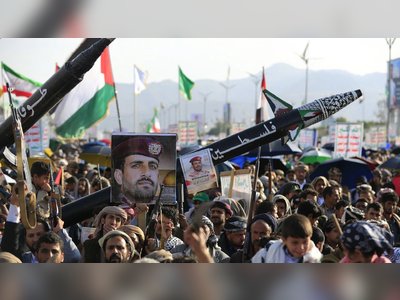
Humanitarian Catastrophe as Residents of Northern Gaza Displaced Again
Escalating military actions force Gazans into dire living conditions amid scarcity of basic necessities.
In recent days, the city of Gaza has witnessed a surge in displaced residents fleeing due to the intensification of Israeli military attacks in the northern regions, particularly in Beit Lahiya and Beit Hanoun.
The renewed displacement has occurred amidst a severe humanitarian crisis characterized by a critical shortage of essential resources such as food and clean water, compounded by restrictions preventing humanitarian aid from entering the area.
Displaced individuals have resorted to makeshift tents, which have become a recurrent feature of their nomadic existence throughout the ongoing conflict, despite a temporary ceasefire that had previously brought some reprieve to the region.
One displaced woman shared her harrowing experience of seeking refuge in the Yarmouk camp on the western outskirts of Gaza after receiving flyers from Israeli forces urging her to evacuate Beit Lahiya.
She expressed profound distress over the challenges faced in these harsh conditions, particularly as her husband remains missing, leaving her uncertain about his fate.
Many displaced persons are struggling with living conditions that include inadequate shelter and limited access to clean drinking water, while refuse piles surround their temporary encampments, exacerbating health risks.
Food and medical supplies are critically lacking, with assertions that Israel is failing to honor aid agreements stipulated under humanitarian protocols.
Another displaced person reported having walked to Gaza without adequate clothing to protect against the cold, expressing frustration at the global community's condemnation of the conflict without substantive actions to halt the ongoing violence.
On Wednesday, Israeli officials announced the commencement of a so-called "limited" ground operation, claiming to have regained control over the Nitzarim axis in central Gaza.
This operation reportedly expanded to encompass additional areas in the north and south of the territory, following the failure to advance to the second phase of a ceasefire agreement, and resuming intense aerial bombardments.
The most recent airstrikes have resulted in the deaths of over 600 Palestinians within a four-day span.
Israeli security sources indicated that preparations are underway for a comprehensive ground assault plan devised by Chief of Staff Eyal Zameer, involving the mobilization of multiple military units, including reservist forces.
In another context, there have been reports from Quneitra province in southern Syria, where local sources indicate that impoverished young men are registering in an Israeli daily labor program.
While many residents express a refusal to work for what they consider an occupying force, the dire economic conditions have compelled some to seek employment opportunities despite the prevailing sentiment.
A local informant revealed that between 60 and 75 young men, primarily from northern Quneitra villages near the disengagement line, have applied for jobs in Israel.
Many have indicated that their decisions stem from desperation rather than any affinity for the Israeli state.
This situation underscores the urgent need for the Syrian government to enhance living conditions for families, as many residents face dwindling resources and limited employment opportunities.
Reports also suggest that aid being distributed by Israeli authorities is sometimes accepted by desperate residents, despite their political stance.
Israeli military operations have intensified in southern Syria since the fall of the Assad regime on December 8, with Israel conducting numerous strikes aimed at degrading Syrian military capabilities while reportedly establishing military bases in the region and exacerbating internal divisions within Syria.
The Israeli media has indicated a plan to recruit Syrian laborers for jobs in the occupied Golan Heights, with initial phases anticipating the arrival of workers for roles in agriculture, industry, and construction, while the Israeli military is expected to maintain a presence in the demilitarized zone indefinitely.
As these dynamics evolve, humanitarian conditions remain dire for those affected by the ongoing conflicts, as residents navigate the complexities of survival amid fluctuating conflict and occupation.
The renewed displacement has occurred amidst a severe humanitarian crisis characterized by a critical shortage of essential resources such as food and clean water, compounded by restrictions preventing humanitarian aid from entering the area.
Displaced individuals have resorted to makeshift tents, which have become a recurrent feature of their nomadic existence throughout the ongoing conflict, despite a temporary ceasefire that had previously brought some reprieve to the region.
One displaced woman shared her harrowing experience of seeking refuge in the Yarmouk camp on the western outskirts of Gaza after receiving flyers from Israeli forces urging her to evacuate Beit Lahiya.
She expressed profound distress over the challenges faced in these harsh conditions, particularly as her husband remains missing, leaving her uncertain about his fate.
Many displaced persons are struggling with living conditions that include inadequate shelter and limited access to clean drinking water, while refuse piles surround their temporary encampments, exacerbating health risks.
Food and medical supplies are critically lacking, with assertions that Israel is failing to honor aid agreements stipulated under humanitarian protocols.
Another displaced person reported having walked to Gaza without adequate clothing to protect against the cold, expressing frustration at the global community's condemnation of the conflict without substantive actions to halt the ongoing violence.
On Wednesday, Israeli officials announced the commencement of a so-called "limited" ground operation, claiming to have regained control over the Nitzarim axis in central Gaza.
This operation reportedly expanded to encompass additional areas in the north and south of the territory, following the failure to advance to the second phase of a ceasefire agreement, and resuming intense aerial bombardments.
The most recent airstrikes have resulted in the deaths of over 600 Palestinians within a four-day span.
Israeli security sources indicated that preparations are underway for a comprehensive ground assault plan devised by Chief of Staff Eyal Zameer, involving the mobilization of multiple military units, including reservist forces.
In another context, there have been reports from Quneitra province in southern Syria, where local sources indicate that impoverished young men are registering in an Israeli daily labor program.
While many residents express a refusal to work for what they consider an occupying force, the dire economic conditions have compelled some to seek employment opportunities despite the prevailing sentiment.
A local informant revealed that between 60 and 75 young men, primarily from northern Quneitra villages near the disengagement line, have applied for jobs in Israel.
Many have indicated that their decisions stem from desperation rather than any affinity for the Israeli state.
This situation underscores the urgent need for the Syrian government to enhance living conditions for families, as many residents face dwindling resources and limited employment opportunities.
Reports also suggest that aid being distributed by Israeli authorities is sometimes accepted by desperate residents, despite their political stance.
Israeli military operations have intensified in southern Syria since the fall of the Assad regime on December 8, with Israel conducting numerous strikes aimed at degrading Syrian military capabilities while reportedly establishing military bases in the region and exacerbating internal divisions within Syria.
The Israeli media has indicated a plan to recruit Syrian laborers for jobs in the occupied Golan Heights, with initial phases anticipating the arrival of workers for roles in agriculture, industry, and construction, while the Israeli military is expected to maintain a presence in the demilitarized zone indefinitely.
As these dynamics evolve, humanitarian conditions remain dire for those affected by the ongoing conflicts, as residents navigate the complexities of survival amid fluctuating conflict and occupation.











